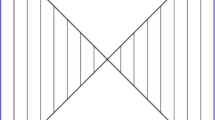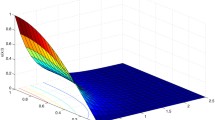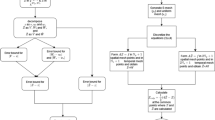Abstract
The convergence of finite element methods for elliptic and parabolic partial differential equations is well-established if source terms are sufficiently smooth. Noting that finite element computation is easily implemented even when the source terms are measure-valued—for instance, modeling point sources by Dirac delta distributions—we prove new convergence order results in two and three dimensions both for elliptic and for parabolic equations with measures as source terms. These analytical results are confirmed by numerical tests using COMSOL Multiphysics.

Similar content being viewed by others
References
Casado-Díaz, J., Rebollo, T.C., Girault, V., Mármol, M.G., Murat, F.: Finite elements approximation of second order linear elliptic equations in divergence form with right-hand side in \(L^1\). Numer. Math. 105, 337–374 (2007)
Chrysafinos, K., Hou, L.S.: Error estimates for semidiscrete finite element approximations of linear and semilinear parabolic equations under minimal regularity assumptions. SIAM J. Numer. Anal. 40(1), 282–306 (2002)
Fujiwara, D.: Concrete characterization of the domains of fractional powers of some elliptic differential operators of the second order. Proc. Japan Acad. 43, 82–86 (1967)
Galouët, T.: Measure data and numerical schemes for elliptic problems. In: Elliptic and parabolic problems. Progress in Nonlinear Differential Equations and their Applications, vol. 63, pp. 279–290. Birkhäuser, Basel (2005)
Gobbert, M.K.: Long-time simulations on high resolution meshes to model calcium waves in a heart cell. SIAM J. Sci. Comput. 30(6), 2922–2947 (2008)
Gobbert, M.K., Yang, S.: Numerical demonstration of finite element convergence for Lagrange elements in COMSOL Multiphysics. In: Dravid, V. (ed.) Proceedings of the COMSOL Conference 2008, Boston (2008)
Grisvard, P.: Caractérisation de quelques espaces d’interpolation. Arch. Ration. Mech. Anal. 26, 40–63 (1967)
Hanhart, A.L., Gobbert, M.K., Izu, L.T.: A memory-efficient finite element method for systems of reaction-diffusion equations with non-smooth forcing. J. Comput. Appl. Math. 169(2), 431–458 (2004)
Lions, J.L., Magenes, E.: Non-homogeneous Boundary Value Problems and Applications. Springer, New York (1972)
Rüde, U.: On the accurate computation of singular solutions of Laplace’s and Poisson’s equation. In: Multigrid Methods (Copper Mountain, CO., 1987). Lecture Notes in Pure and Applied Mathematics, vol. 110, pp. 517–540. Dekker, New York (1988)
Scott, R.: Finite element convergence for singular data. Numer. Math. 21, 317–327 (1973)
Thomée, V.: Galerkin Finite Element Methods for Parabolic Problems, 2nd edn. Springer Series in Computational Mathematics, vol. 25. Springer, Berlin (2006)
Trott, D.W., Gobbert, M.K.: Finite element convergence studies using COMSOL 4.0a and LiveLink for MATLAB. Technical Report HPCF-2010-8, UMBC High Performance Computing Facility, University of Maryland, Baltimore County (2010). http://www.umbc.edu/hpcf
Trott, D.W., Gobbert, M.K.: Finite element convergence for time-dependent PDEs with a point source in COMSOL 4.2. In: Rao, Y. (ed.) Proceedings of the COMSOL Conference 2011, Boston (2011)
Acknowledgments
The authors are indebted to Andreas Prohl for valuable input to the analysis of this paper. The hardware used in the computational studies is part of the UMBC High Performance Computing Facility (HPCF). The facility is supported by the U.S. National Science Foundation through the MRI program (Grant no. CNS-0821258) and the SCREMS program (Grant no. DMS-0821311), with additional substantial support from the University of Maryland, Baltimore County (UMBC). See http://www.umbc.edu/hpcf for more information on HPCF and the projects using its resources. M. Kružík was partially supported by the grants IAA 100750802 (GA AV ČR), P201/10/0357, and P105/11/0411 (GA ČR). D. W. Trott also acknowledges financial support as HPCF RA.
Author information
Authors and Affiliations
Corresponding author
Rights and permissions
About this article
Cite this article
Seidman, T.I., Gobbert, M.K., Trott, D.W. et al. Finite element approximation for time-dependent diffusion with measure-valued source. Numer. Math. 122, 709–723 (2012). https://doi.org/10.1007/s00211-012-0474-8
Received:
Revised:
Published:
Issue Date:
DOI: https://doi.org/10.1007/s00211-012-0474-8




